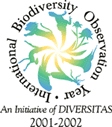| |
Why do we need IBOY?
The Earth's biodiversity is a capital resource that provides
vital ecosystem services, goods such as food, fuel, fiber and
medicines, and the aesthetic, recreational and cultural riches
associated with nature. It remains a poorly understood scientific
frontier, with an estimated 90% of species yet to be discovered
and described.
Alarmingly, this biological diversity is being lost across
the planet, at all levels of organization from genes, through
species, to landscapes. Biologists generally believe that these
losses represent a threat to Earth system functioning and the
well-being of human societies. Yet this concern does not seem
to be penetrating the public's consciousness, much less the policy
and planning processes of many nations.
In short, biologists have not yet made a compelling case
for general concern and action about the loss of biodiversity
and its potential consequences for human society.
 (top) (top)
What will happen as part of IBOY?
DIVERSITAS-IBOY 2001-2002 will be a time of celebrating and
promoting observations of biodiversity. It will focus global
attention on the Earth's biological diversity, its contributions
to Earth system functioning and society, and the voyages of discovery
that are revealing its treasures through science, exploration,
art, and education.
The official launch date for IBOY 2001-2002 is December
29, 2000, designated by the United Nations as a global "Day
of Biological Diversity."
DIVERSITAS-IBOY is a grassroots effort of the international
scientific community. Biologists, social scientists, educators,
and media professionals worldwide continue to assemble a wide
array of projects exploring various aspects of biodiversity.
In keeping with this global focus, projects are international
in scope but are complemented by national and regional efforts.
DIVERSITAS-IBOY projects will:
- Push the frontiers of biodiversity science
- Forge links to develop a new integral science
- Make new information on biodiversity available to a wide
audience
- Provide focused information for policymakers
- Engage and educate the public
Through the establishment of global observation programs,
IBOY will provide new information on the three main levels of
biological diversity: genes, species, and ecosystems. It will
strengthen interdisciplinary and international collaborations,
with the aim of providing sound data on the biological, economic,
and social implications of trends in biodiversity. These will
be fundamental tools for informed decision-making by policy-makers
worldwide.
Each project participating in IBOY will deliver a product
during 2001-2002. Many are initiating longer-term programs and
new avenues of communication, extending the benefits of IBOY
for years to come.
 (top) (top)
What Information will IBOY Provide?
IBOY projects address the questions:
What can the scientific, educational,
arts, and media communities do to participate in IBOY?
First and foremost, these communities need to put forth proposals
for programs that are desirable for inclusion in the DIVERSITAS/IBOY
effort. These proposals should have a global reach but can incorporate
national and regional efforts. Importantly, they should be designed
to deliver a product in the year or so duration of the program.
The projects should provide important and exciting dimensions
for biodiversity research , education, and outreach to engage
the interest of the general public, funders and policy-makers.
Please contact Dr.
Gina Adams at the IBOY Secretariat
to propose projects for inclusion in IBOY or to request further
information about how you can participate in the IBOY effort.
You may also download a project information
form.
 (top) (top)
History and Origins
of IBOY
|
The International Biodiversity Observation Year is an
initiative of DIVERSITAS,
an international program of diversity science, which promotes
and synthesizes scientific research on biodiversity. The idea
for IBOY originated with DIWPA,
a regional arm of DIVERSITAS in the Western Pacific and Asia.
IBOY has been formally endorsed by the 16th International
Botanical Congress (IBC)
and the World Conservation Union (IUCN).
DIVERSITAS sponsors are: the International Council for Science
(ICSU), International Geosphere-Biosphere
Program (IGBP), International
Union of Biological Sciences (IUBS), International Union of Microbiological
Societies (IUMS),
Scientific Committee on Problems of the Environment (SCOPE),
and the United Nations Educational, Scientific and Cultural Organization
(UNESCO).
|
 Read an
essay detailing the history, precedents, and aims of IBOY, by
H. Mooney et al. Read an
essay detailing the history, precedents, and aims of IBOY, by
H. Mooney et al. |
|
 (top) (top)
|

